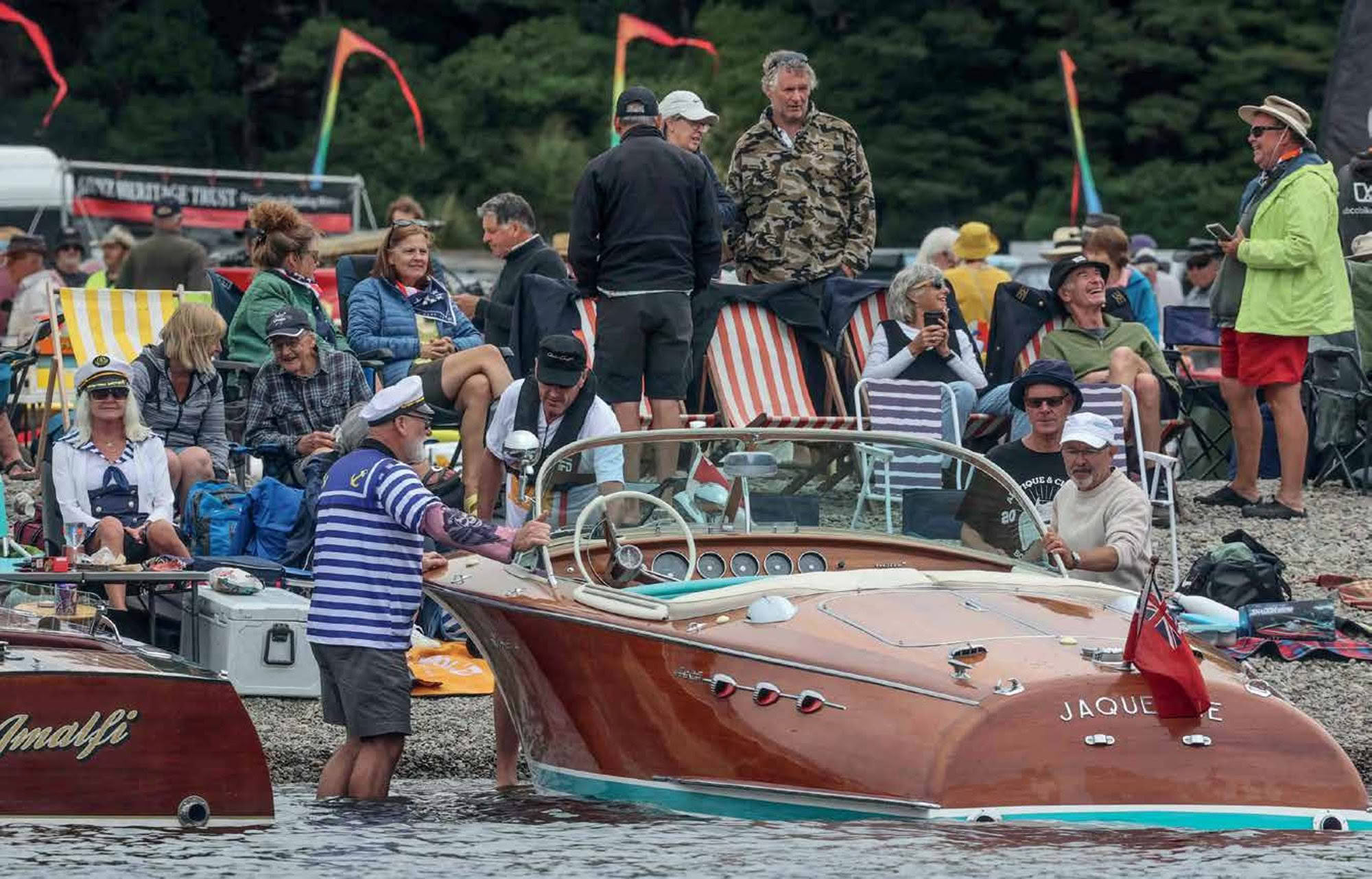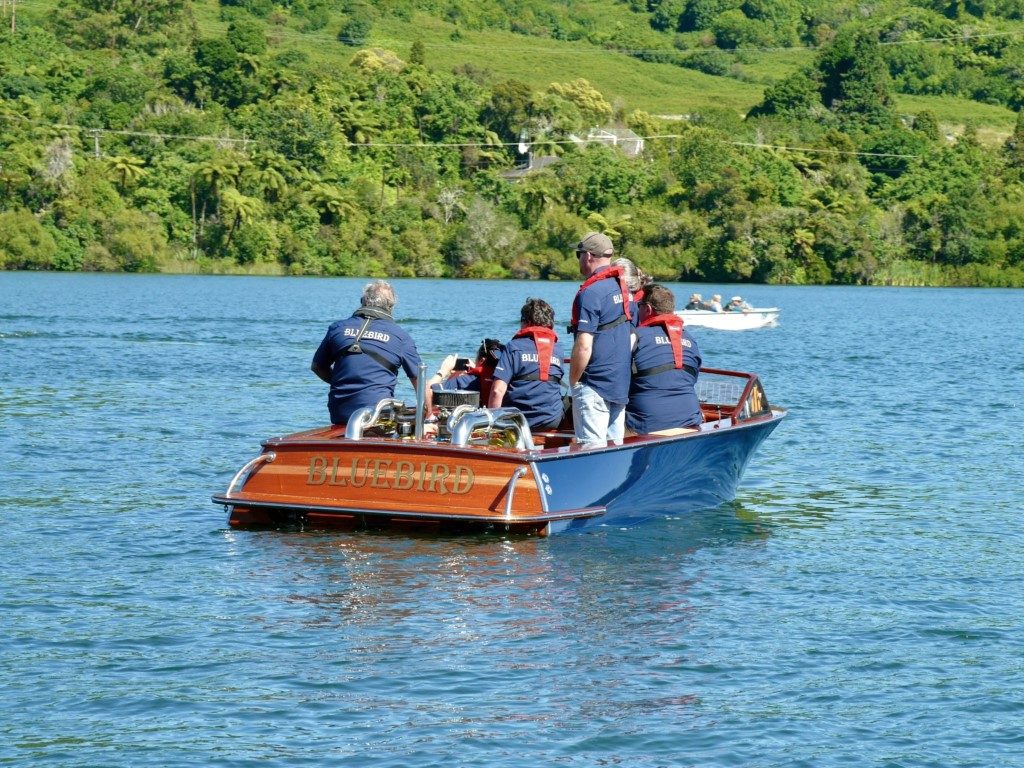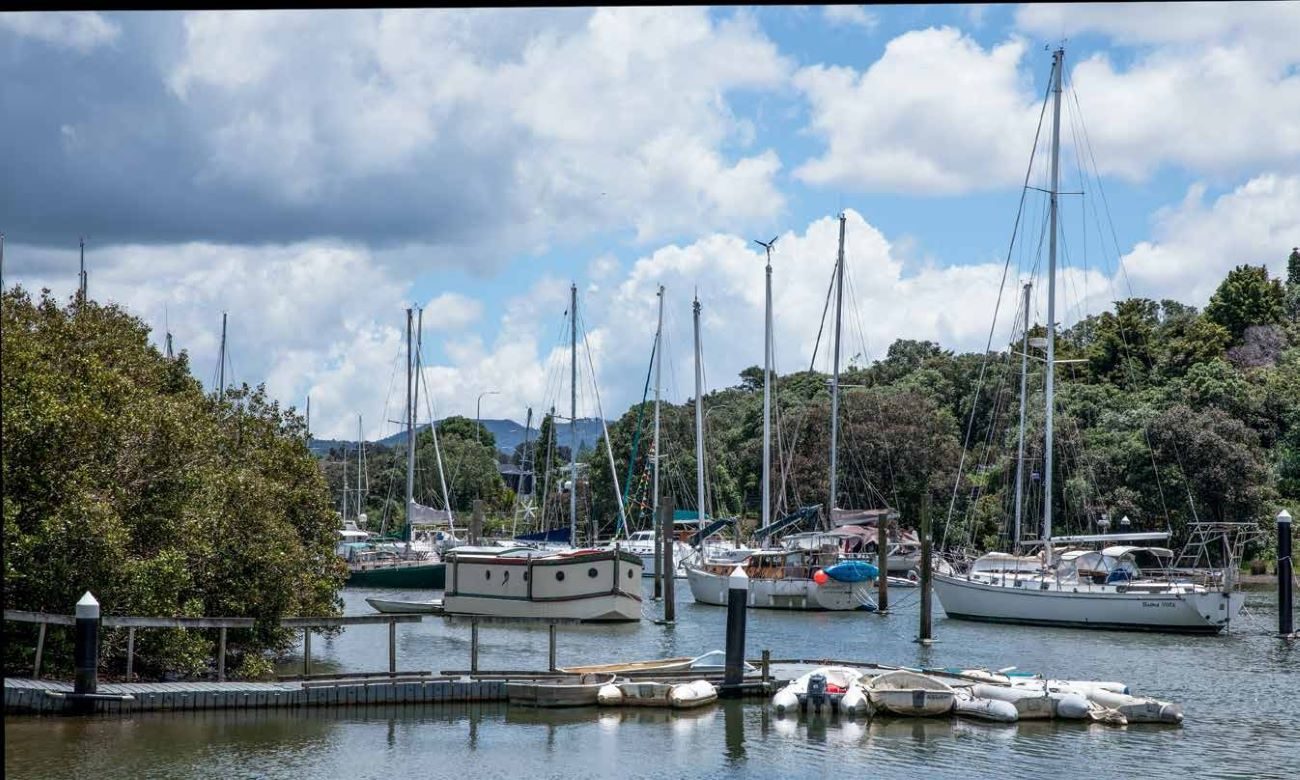

We did it tough to file this story, beating a hundred miles each way in stern breezes. But it was well worth it; for this is an Up the Creek adventure with everything, plus a cherry (a golden one) on top!
Approaching the dramatic Whangarei Heads with their Gormenghast-like rock spires is knowing you’ve arrived at a worthy harbour.
At the entrance you pass Smugglers’ Bay, Busby Head, Frenchman and Calliope Islands, and Snake Bank (all harbours should have place names like this, eh) – and you know there’s much history and epic tales to be experienced here. Where we’re heading is justifiably a sought-after haven for yachts inbound from the vast blue Pacific – and the base for many fine boatyards too.
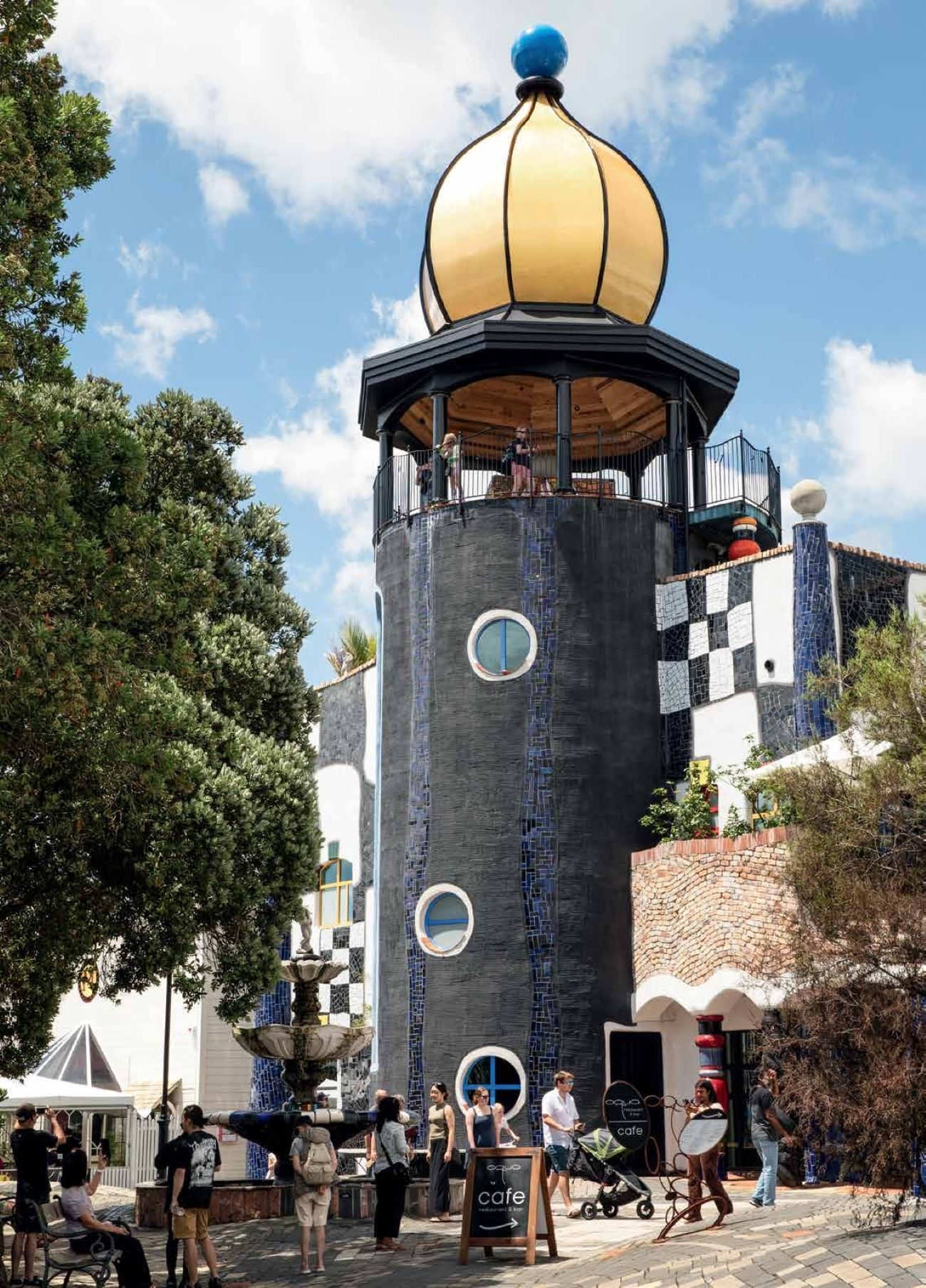
All the markers mentioned above are on the starboard side of the entrance channel. It’s almost as if the chart is calling out ‘Look this way!’ because on the port side are the less-than-lovely Marsden Point refinery’s towering towers, and NorthPort’s shipping wharves, giant cranes and stacked primary industries cargo ready to leave our shores.
So you keep on going up a wee way, veering to the right of Snake Bank and away from the main channel – at this point named Shell Cut Reach – around Reserve Point, and into The Nook. This is one of the loveliest anchorages we’ve encountered in Te Ika a Maui the North Island. Certainly the most favourite one for Skyborne (our 12m cruising catamaran), Lesley and me.
Once ensconced in The Nook, and sheltered from almost all winds, the refinery etc are out of sight, sound and mind; and the sublime, deep-green bush-clad South Seas poster peaks and emerald water are all still all around you.

As an added bonus you know there are kiwi up in those hills, looked after by local volunteer conservation groups. Across the way, a dinghy ride aways (or you can also anchor right close among the moored yachts) there’s the historic waterside Parua Tavern, with its own jetty and pints of Wild Buck ale, and stonefired shrimp-topped pizzas. And where you can get yourself photographed as a genuine pirate.
Now that’s what I’d call a fine start to an Up the Creek adventure! And there’s way more to come.
Just westwards along Whangarei Heads Road from here there’s freedom camping, an outboard boats club, a yacht club and their slipways. Going east, toward the Heads, The Nook and Urquharts Bay (also a good anchorage), there’s a pubic wharf, then a community centre with Gas station, Four Square and country school. Classic Kiwi stuff. Even, as we walked up from the beach to the store, roadside folk art in the form of a coupla tree stumps covered in lost, single jandals.
That evening at the pub, Lesley bumps into and old sustainability associate, and he tells her that in his protected block of bush, rare pātiki brown teal have made themselves at home and are raising ducklings.

At the gas station there’s the funkiest informative sign about the kiwi recovery efforts in the hills. And with local businesses with names like Sharon Grace Teddy Bears, Tranquility Bay Care, Bayview Miniature Horse Stud, Culina Glass, Rawkos Fabrics & Design, this appears to be a community of interesting people who have found their preferred place on this good earth.
But we are focused on the waterway. Lesley does a tiki tour around Parua Bay in the rubber dinghy, photographing a bunch of more-than-interesting boats. On anchor watch, I delve into the history of the bay, to discover that in the bad ol’ days of an 1849 hydrographic survey of Whangarei Harbour, Captain Lort Stokes in the paddle-steamer HMS Acheron named it ‘Bad Maori Bay’ and what’s now Manganese Point was dubbed ‘Annoyance Point.’ Grumpy bugger.
In The Nook I can’t help chatting to the locals – bach owners (lucky people!); and the not-so-locals aboard Captain Nemo – an extraordinary, fast aluminium passage maker of French design now based in Tahiti, just visiting (story coming soon). And sharing fresh Central Otago cherries – the traditional and much appreciated Christmas gift from Boating NZ magazine to its writers.

I learn too that at The Nook, James Irwin Wilson (an Irish surveyor) settled in 1858. He fell for Joanna Munro, daughter of a Nova Scotian settler from Munro Bay. But her father, John Munro (another grumpy bugger), was peeved that Wilson had bought the land first. He wanted it. So he opposed them marrying.
James and Joanna tried to elope but were caught. The second elopement was successful. They headed south and were married in Auckland. Hooray! John Munro mellowed and accepted the marriage; and even when one of James’ brothers later married Joanna’s sister. (I couldn’t find their names, sorry.)
But the rest of the creek beckons! And it’s bigly. Muchly.
In days gone by, ships would steam 10 more miles up the channel to dock at what’s now known as the Old Port, and currently home to two extensive boatyards, Harbourside Boatworks and Oceania Marine. That latter specialising in haulouts of really big yachts. Our smaller Skyborne had a refit there after a taxing Tasman crossing.
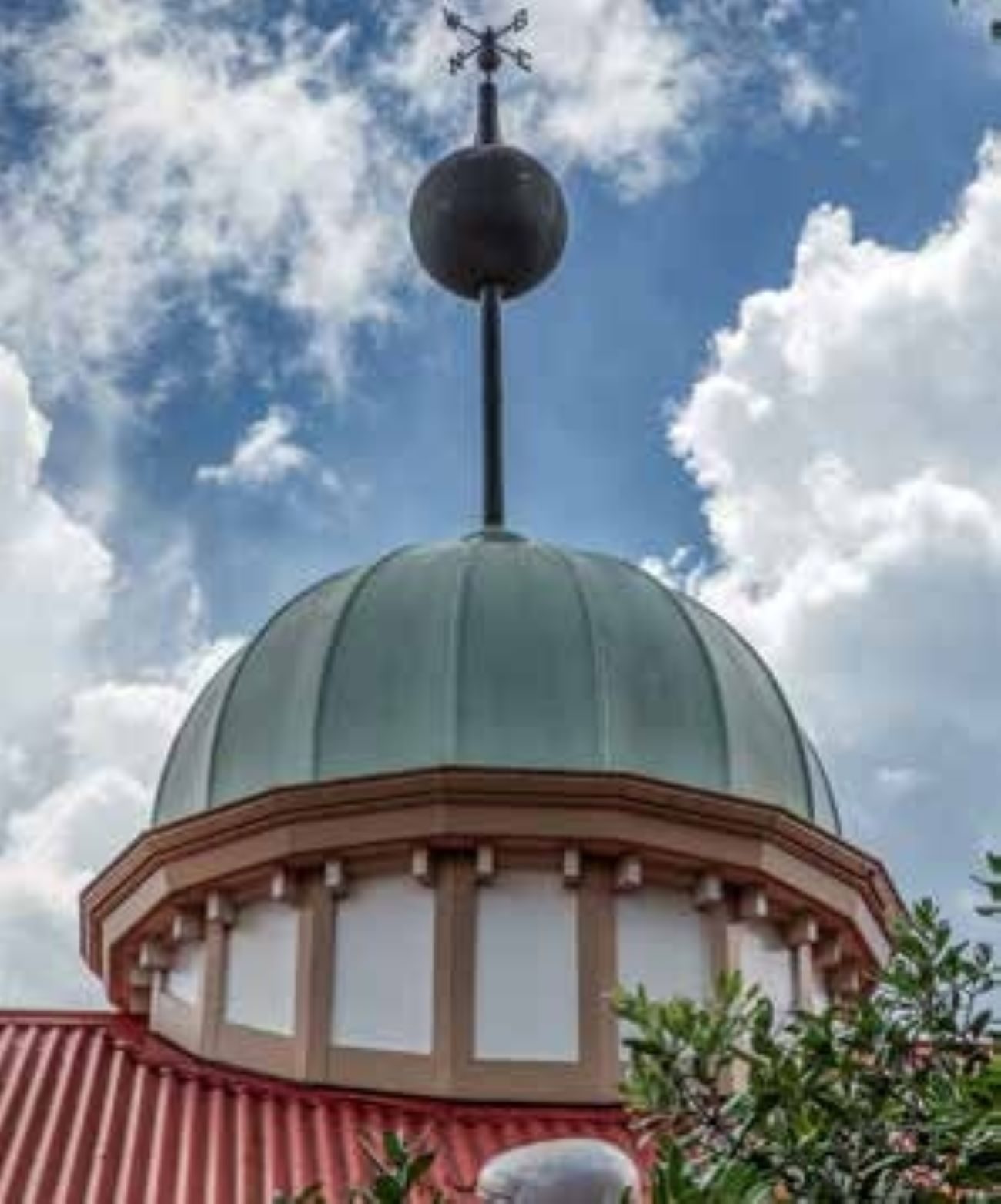
And big ships still do head up to the wharf for the Portland cement works, veering to port after Tamaterau Reach and up Portland Reach, between Limestone Island and its old cement works ruins (intriguing history), and Rat Island (oerr…) and Knight Island (better).
The long, snaking main harbour then takes a turn around a curving headland that accommodates Whangarei Airport, departing from its general NW direction just past a marine reserve in Wellington Reach, to the due north-south Kioreroa Reach. And it narrows considerably here.
The Whangarei marine reserve is in two parts, Waikaraka this upstream section, mostly mangrove/mudflats habitat; and Motukaroro, rocky shoreline around the eponymous small island opposite Marsden Point.
The reserves are unique in originally having been proposed by a dedicated group of students from Kamo High School. One of them, Samara Nicolas now runs a nationwide business Experiencing Marine Reserves, where they take schoolkids snorkeling at their local bay, then the nearest marine reserve, just to see the difference. The best of experiential education. They call it Te Kura Moana – the School of the Ocean.
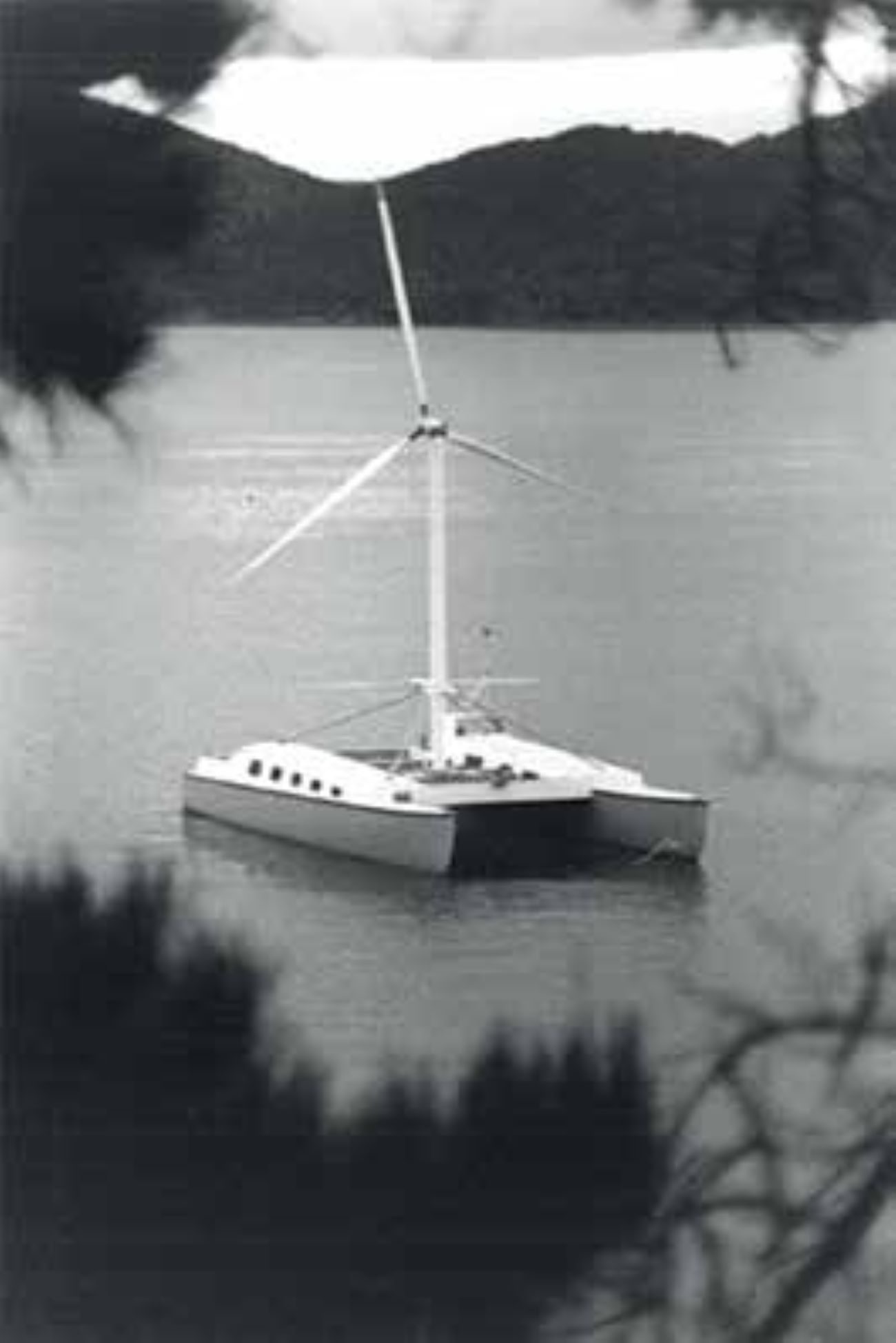
Up this long straight stretch, it would pay to have a yacht that can sail straight into the wind. And so – cue Kiwi ingenuity – sure enough there was. One of the first viable windmillrigged sailboats, Jim Bates’ catamaran Te Whaka, that graced Whangarei Harbour (sort-of) in the late 1970s.
Bates claimed seven knots boatspeed directly into the wind. This became the target for another innovative Kiwi designer Rob Denney, which he never achieved with his own experimental windmill boat. So he switched to designing proas. I’ll tell you about those ultra-interesting boats, a development from both Pacific and Atlantic proas, another time. In the end, Bates and Te Whaka cruised 4,000 miles, and he claimed that no-one on his boat ever got seasick!
But things got complicated anyway: an Australian named Lin Olen filed his invention ‘A Propulsion Unit’ in Canberra, in 1974 (application number PB 6924). Olen wrote: “Jim Bates of Whangarei, NZ built his Te Whaka [catamaran] almost exactly to my disclosure.” We’ll leave it there.
I had phoned ahead to Kara Gribble at the Whangarei Marina at the Town Basin in the heart of the Whangarei CBD. She kindly offered us a ringside berth, right in front of the world-famousin-New-Zealand Clapham’s National Clocks Museum, with its groovy giant gnomon (the angled device of a sundial).
Inside there’s more world-class-interesting stuff. Like a Blaise Bontems Singing Birds Automation Clock – ‘A fine example of French craftsmanship that comprises of a tree with nine birds and waterfall’ (!).
And outside, the Timeball Clock, which drops an orb (slowly, stutteringly) every day at exactly noon. This harks back to an old harbour tradition where timeballs, usually situated on prominent headlands or hills, allowed ships’ navigators to accurately set their chronometers. Which was necessary as a way of finding longitude, when we still relied on celestial navigation with sextants and tables and trying. This is a replica of the old devices.

Then there’s the Rolling Ball Clock, which as its blurb says, ‘… is a fusion of science machine, artistic kinetic sculpture, tourist attraction and cultural stage.’ The visible moving parts, and the captive ‘Pedal Man’ captivated Lesley and her lens. And just a few paces downstream of the also genuinely world-famous Hundertwasser Arts Centre.
It’s dedicated to the memory of the unique (and the term is used knowingly here) Austrian artist and architect Friedensreich Regentag Dunkelbunt Hundertwasser, who came to love New Zealand and lived here in his later life.
It would be impossible to sum up his life’s work in a wee catch-all, but here’s a try: In his original and unruly artistic vision, Hundertwasser stood as a colourful opponent (in all senses of the word) of ‘a straight line’ and any standardisation. You’ll see.
He also designed an alternative Koru Flag for New Zealand, which found much favour among our own hippies and other alternative communities, back in the 1980s.
The arts centre also hosts other ongoing exhibitions, significant in the New Zealand arts scene. Right now, He Wai Ngunguru Nomads of the Sea by Lisa Reihana; and Kei Muri Ngā Mea I te Rā, by Shane Cotton.
In the precinct there are great restaurants and gift shops too.
Trouble was, Skyborne was so happy at The Nook, she showed that the starboard motor wouldn’t provide thrust in reverse. Revving the two motors in opposition, we can spin the 7.5m-wide cat in its own length; but suddenly the prospect of a tight marina parking appeared daunting.
So for the photos, Lesley caught a ride up to the Old Port on Captain Nemo, then went the rest of the way in the rubber dinghy. Brian Caulton at the marina treated her like royalty; and in the small boat, she had plenty of space for parking it!
But we’re getting ahead of ourselves, for towards the Northern end of Kioreroa Reach are more boatyards, including Norsand who specialise in slipping wide multihulls. Friends of ours with a trimaran that’s 10m wide – well Norsland is the only place they can haul out. And Simon and Yolanda say that the Norsand folk always take good care with their beautiful Newick-design Lady Butterfly.

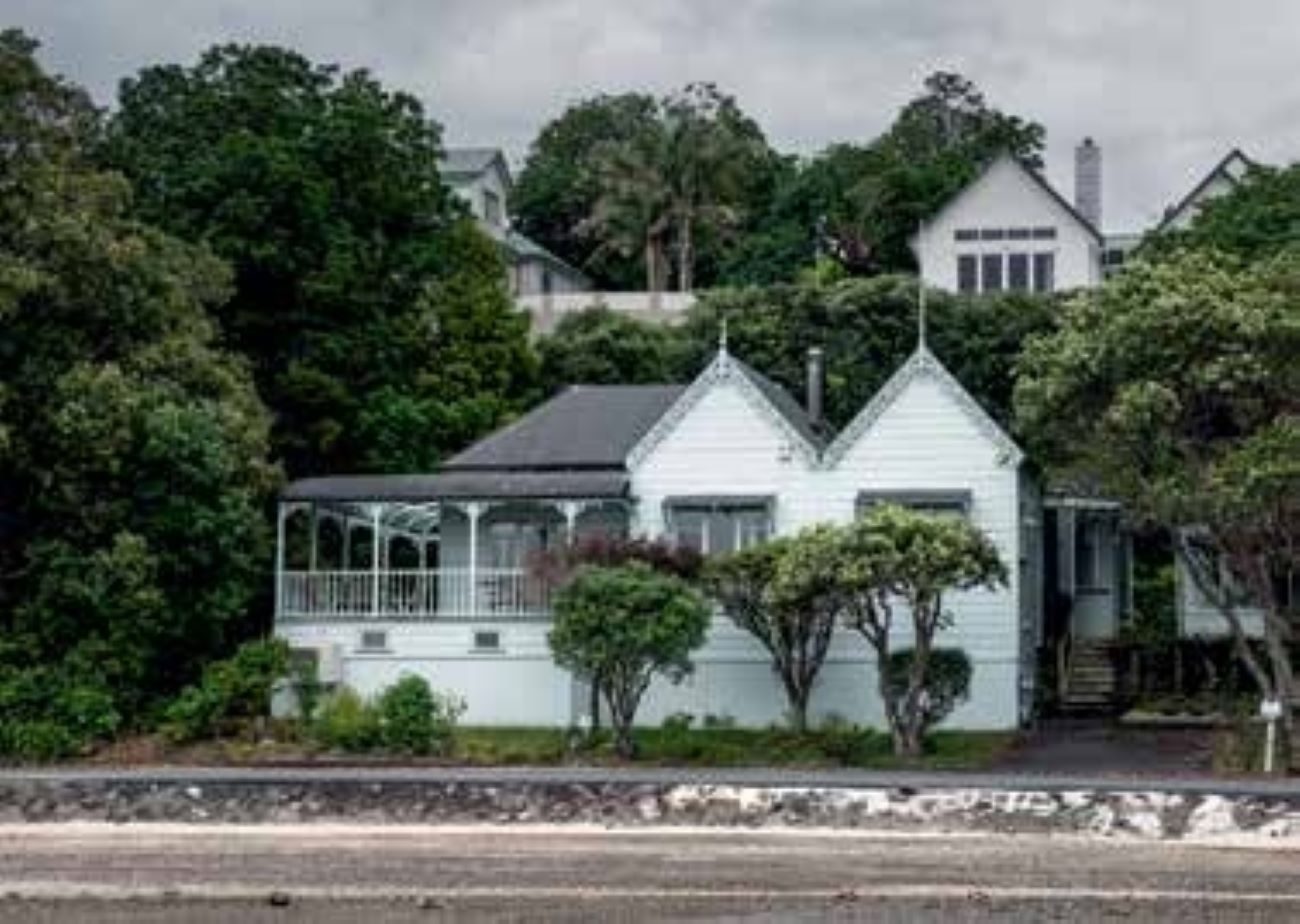
Just beyond Norsand, the creek does a sharp zig-zag to the West and then Northwards again around the delightfullynamed Kissing Point, with the Whangarei Cruising Club on the northern shore. And next to the best dog-exercising park, just so you know.
As the channel turns north again, now known as the Hātea River, the big feature is the elegant bascule (pivoting upwards) bridge Te Matua ā Pohe. No worries going under it in the rubber dinghy, but if you have a tall yacht mast over 6.5m, just call Bridge Control on Channel 18, and they will generally lift it within 10 minutes.
But not at Whangarei rush hour – between 7am and 9am and 4pm and 6pm weekdays. If you do have to wait a bit, there are pontoons to tie up alongside, both upstream and downstream of the bridge. Te Matua ā Pohe – the fishhook of Pohe – cost $32 million to build. It’s a distinctive work of art that adds to the Whangarei river- and townscape.
History runs deep here. Naturally the extensive harbour was a place of great resource value to Māori. Around the shores were many, many kāinga (villages) and pā (fortified sites). And later, in 1840, Surveyor-General Felton Mathew decided against Whangarei as a possible site for the capital of New Zealand, because the water wasn’t deep enough for ships at the Town Basin.
And there wasn’t enough flat land either. (Most of the CBD is on land reclaimed from mudflats between the 1920s and the 1960s.) So the Opua Wharf was built two miles downstream by the Railway Department and opened in 1904. At first known as ‘Port Kioreroa’, it became ‘Port Whangarei’ in 1938; and now the ‘Old Port.’
NorthPort, the new port at Marsden Point right at the mouth of the estuary, was established in 2000. Fun fact: their tugboats, operated by North Tugz, handle some of the biggest ships entering New Zealand waters, tankers to the Marsden Point Oil Refinery.

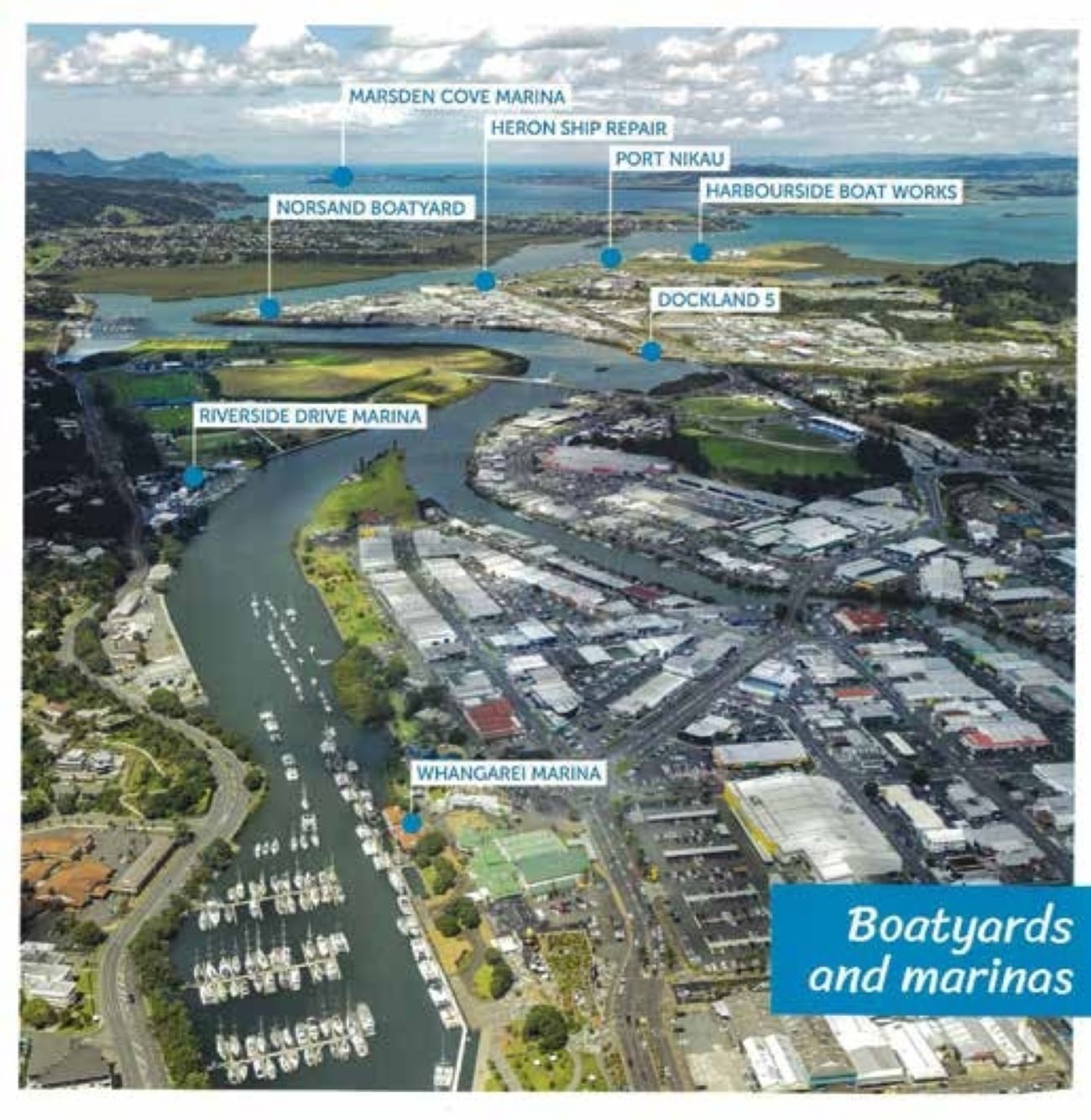
Marsden Cove Marina, just upstream from it and also on the southern bank, is the designated customs clearance port in these parts for incoming international yachts.
From the mid-1850s the good ship Petrel, owned by Māori Chief Tirarau and captained by Roert Mari and T S Carmichael, carried passengers, mail stores and produce between Whangarei and Auckland. And supplemented by a fleet of sailing cutters, ketches and schooners, which carried people, fruit, flour, bacon, butter, kauri gum, firewood, coal (from nearby mines), timber and livestock to the markets of Auckland.
Other ships doing the run were the Wonga Wonga (cool name!) between 1855 and 1860s, and from 1877, the SS Argyle and SS Stormbird. They became the nucleus for the fleet of the Northern Steamship Company, and provided comfortable travel until the railway link was completed in 1925, and the first ‘allweather’ road only in 1934(!).
There’s more riverside sculpture on the Town Basin Loop Track Sculpture Trail, which follows the Hātea River through parkland just south of the Town Basin. With 16 impressive works situated on the riverbank, and culminating with the Waka and the Wave work, opposite the Riverside Drive Marina.
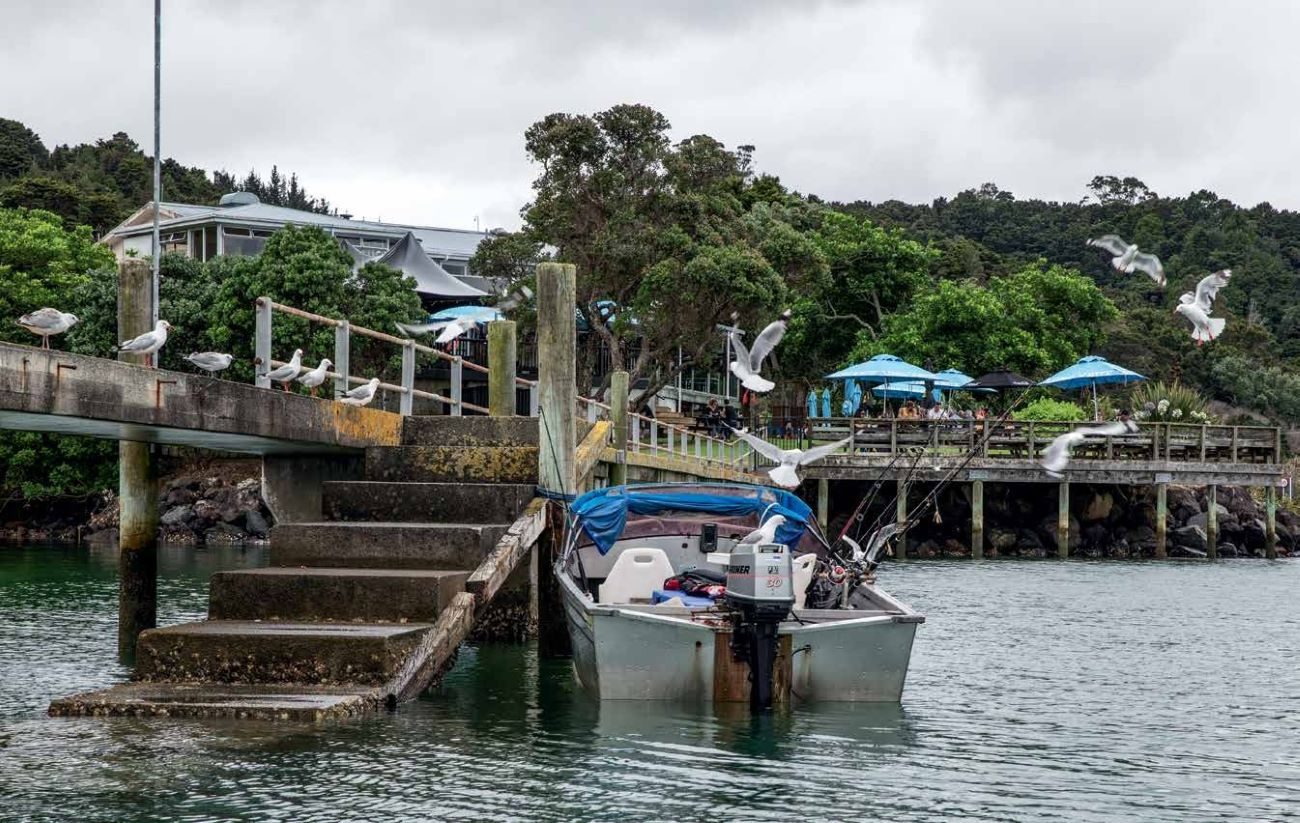
The commission for Waka and the Wave brought together two pre-eminent New Zealand tohunga whakairo (sculptors) from Māori and Pākehā heritage, Te Wahiri Hetaraka and Chris Booth. An epic new kids’ playground there is pretty sculptural too.
But the golden cherry on top of this Up the Creek must surely be symbolised by the cupola of the Hundertwasser Arts Centre. It glows in the sunlight, atop the funkiest building (natch, to reflect the quirky artist himself) like the central attraction that it knows it surely is.
We haven’t even begun to outline all the other attractions of Whangarei and its Town Basin. Do go check it out. It’s a worthy cruising destination for all yachts and launches, local and international. Suffice to say, this is an Up the Creek that’s worth getting to, lingering in and exploring for quite some time. Laid-back Northland time. All good. BNZ



